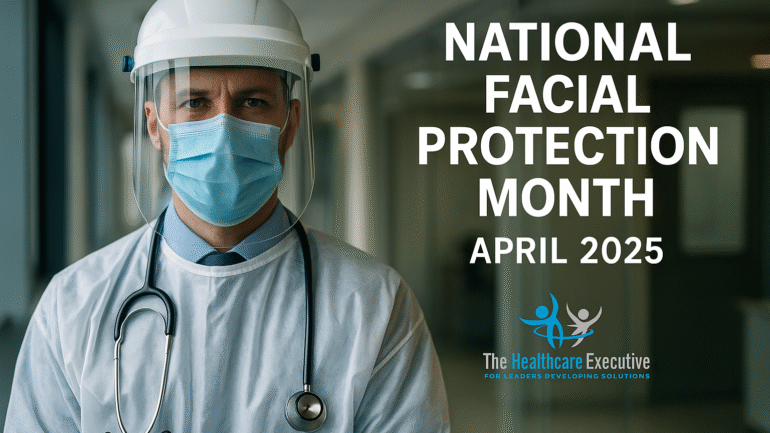National Facial Protection Month – April 2025

- Posted by Greg Wahlstrom, MBA, HCM
- Posted in Health Observance Calendar
Executive Strategies to Prevent Trauma and Promote Safety
Published: April 6, 2025
National Facial Protection Month, observed each April, serves as a vital reminder to prioritize trauma prevention, patient safety, and protective protocols throughout the healthcare system. Facial trauma from sports injuries, workplace accidents, or emergency incidents can result in long-term consequences ranging from disfigurement to speech and respiratory impairments. Executive leadership must ensure clinical settings—from emergency departments to dental clinics—are equipped with trauma-informed protocols that include protective gear access, clear safety signage, and multidisciplinary care coordination. Organizations like the American Association of Oral and Maxillofacial Surgeons highlight the growing role of facial injury prevention in public health planning. Preventing injury is just as critical as managing it. Health system leaders must integrate facial protection into their broader strategic frameworks for quality, safety, and risk mitigation.
Hospitals and clinics must proactively establish policies on protective equipment use, particularly in high-risk environments such as operating rooms, urgent care settings, and pediatric dentistry. Leading institutions like Mount Sinai Health System incorporate facial trauma care into training programs for surgical, dental, and emergency staff. This level of integration supports not only clinical competency but systemic accountability. As we explore in The Healthcare Workforce Crisis: Executive Solutions That Actually Work, empowering frontline teams with tools and safety standards improves workforce morale and patient outcomes. Policy without protection is performative. Leaders must go beyond awareness by embedding safety equipment and facial protection training into performance measures and operational dashboards.
Healthcare executives should also be engaging with community partners and local schools to extend awareness efforts beyond hospital walls. Many cases of facial trauma occur during recreational activities—especially for children and adolescents. Systems like UCLA Health have developed outreach programs targeting youth injury prevention through protective gear education and pre-season screenings. These public-facing efforts reinforce hospital credibility, build community trust, and reduce downstream trauma-related admissions. Strategic executives should treat prevention campaigns as both public health imperatives and brand-building opportunities. A community that sees its hospital as a protector—not just a provider—is more likely to engage with preventative care services and digital outreach campaigns.
From a governance perspective, chief quality officers and chief operating officers must include facial protection initiatives in broader safety reporting structures. Metrics should include incidents of preventable trauma, protective equipment compliance rates, and staff engagement with training modules. In our article Trust as a Strategic Asset: Reputation, Outcomes, and the Patient Voice, we emphasize how transparent tracking and improvement initiatives build long-term reputation value. Safety isn’t a siloed department—it is a core business function. Aligning facial protection month initiatives with compliance dashboards, DEI reporting, and annual quality plans ensures they become sustainable elements of institutional culture.
April 2025 is not just a time for posters and protocols—it’s a call for healthcare leadership to act. Health systems that proactively address facial protection demonstrate a broader commitment to anticipatory care, staff readiness, and patient dignity. Whether upgrading personal protective equipment, implementing trauma-informed design in emergency rooms, or launching public education campaigns, these actions signal high-performance governance. At The Healthcare Executive, we encourage leaders to approach National Facial Protection Month not as an event, but as a launching point for long-term safety transformation. When safety is championed at the executive level, it filters down into every policy, every procedure, and every point of care.
Discover More
To continue exploring how healthcare executives shape safer systems through operational excellence and preventative strategies, we recommend this related article from our blog.
Internal Links
- The Healthcare Workforce Crisis: Executive Solutions That Actually Work
- Trust as a Strategic Asset: Reputation, Outcomes, and the Patient Voice



